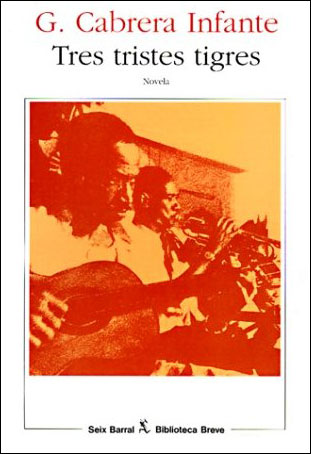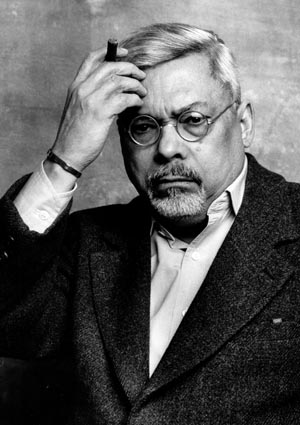GUILLERMO CABRERA INFANTE, “TRES TRISTES TIGRES” FELIZ CUMPLEAÑOS.
Considerada una de las propuestas más importantes de las letras hispanoamericanas, Tres tristes tigres se caracteriza por el uso ingenioso del lenguaje, introduciendo coloquialismos cubanos y constantes guiños y referencias a otras obras literarias, volviéndose un texto complejo y de gran riqueza lingüística, fuertemente oral, que recrea el ambiente nocturno de La Habana de 1958, a través de las andanzas de tres amigos en el transcurso de una noche.
Los escritores Leonardo Padura, Julio Ortega y Hernán Lara Zavala explican la relevancia de ‘Tres tristes tigres’, novela cumbre de Cabrera Infante, que este año cumple medio siglo de haber sido publicada.
“Hay un elemento de carácter legal que complica la posibilidad de que la obra de Guillermo se edite en Cuba. Él pidió que no se publicaran sus libros en la isla, mientras el sistema político no cambiára. Y sus albaceas cumplen ese mandato-deseo… Ojalá muy pronto toda su obra sea publicada en Cuba”, añade Leonardo Padura.
Para el crítico literario peruano Julio Ortega, es la mejor apología de la lengua urbana en la novela latinoamericana. “Su genialidad radica en su lenguaje, y en la manera de recrear las clases sociales, los grupos étnicos, las generaciones y los géneros; en cómo funde la cultura literaria y la cultura de la calle. Nos dice que el habla oral es democratizadora y es una metáfora de la mezcla, ese principio moderno de nuestra creatividad”.
El catedrático de la Universidad de Brown señala que lo más singular de esta novela es el entusiasmo de ese lenguaje. “Es un habla que afirma lo vivo, critica lo establecido y amplía con su vitalidad nuestra posesión del presente. Pocos libros tienen esa plenitud”.
En cuanto a la Cuba que recrea esta obra, el experto en literatura latinoamericana asegura que los jóvenes amigos protagonistas viven la ciudad como el espacio del espectáculo. “Recorren las avenidas, que en La Habana dan al malecón, y convierten cada lugar en un templo de la música, de la memoria celebratoria, de la conversación festiva. Como el espectáculo sólo se da en la duración, celebran la vitalidad de su tiempo fugaz que es, por ello, más pleno”.
A 50 años de su publicación, el también escritor piensa que Tres tristes tigres sigue recreando la identidad de los cubanos. “En verdad, las grandes obras siguen ocurriendo en el presente de la lectura. No las afecta lo típico, la moda, el éxito banal. La vivacidad de la voz como medida temporal la aprendió Cabrera Infante en la literatura latina, en el Satiricón de Petronio, en las Odas de Horacio y en el Arte de amar de Ovidio”.
Por su parte, el crítico literario mexicano Hernán Lara Zavala confiesa que esta novela “le evoca la música cubana, la vida nocturna en La Habana durante los años previos a la Revolución, con sus cabarets, cines, putas y vida bohemia y, por supuesto, el habla coloquial salpicada por el agudo sentido del humor de Cabrera Infante”. El escritor piensa que Tres tristes tigres tiene en común, con algunas obras del Boom literario, “la exploración de una ciudad tan emblemática para Latinoamérica como La Habana, con sus voces, ritmos y cachondería.
“Lo que la hace singular es el temperamento de Cabrera Infante: juguetón, burlón, amargón, prestidigitador de la palabra, amante del cine, la música y de La Habana de los 50 que vivió durante sus años de juventud, donde hay un fondo de amor y nostalgia”, destaca.
Para el narrador, “los tres amigos representan la juventud perdida” y, a 50 años, esta obra “es un testimonio de una Cuba ida para siempre”.
Lo que continúa es la vigencia de esta novela publicada por Seix Barral en Barcelona, en 1965, y dos años después se editó en Londres una versión ampliada y revisada.
La obra, que recibió en 1970 el Premio al Mejor Libro Extranjero, sigue considerándose la pieza cumbre de Cabrera Infante, quien, aunque adquirió la nacionalidad británica en 1979, siempre llevó a la isla caribeña, en el corazón.
Excelsior/Virginia Bautista, Mexico/Extractos/Internet Photos.
The Cuban History, Hollywood.
Arnoldo Varona, Editor.
GUILLERMO CABRERA INFANTE, “TRES TRISTES TIGRES” HAPPY BIRTHDAY.
Considered one of the most important proposals of American literature, TTT is characterized by the clever use of language, introducing Cuban colloquialisms and constant winks and references to other literary works, turning a complex text and great linguistic wealth, strongly oral, recreating the nightlife of Havana, 1958, through the adventures of three friends in the course of one night.
Writers Leonardo Padura, Julio Ortega and Hernán Lara Zavala explained the relevance of ‘Three Trapped Tigers’ Cabrera Infante novel summit, which this year celebrates half a century of being published.
“There is an element of a legal nature which implies the possibility that William’s work is published in Cuba. He asked that his books are not published in the island, while the political system will not change. And his executors fulfill that mandate-desire … Hopefully soon all his work is published in Cuba says cuban writer Leonardo Padura.
For the Peruvian literary critic Julio Ortega, it is the best apology of urban language in the Latin American novel. “His genius is its language, and how to recreate social classes, ethnic groups, generations and genders; how melts literary culture and street culture. We say that oral speech is democratizing and mix a metaphor, the modern principle of our creativity. ”
The professor of Brown University points out that the most singular of this novel is the enthusiasm of that language. “It is a speech that said the living, criticizes the established and expanding its vitality our possession of this. Few books have that fullness. ”
As for Cuba that recreates this work, the expert in Latin American literature ensures that young friends protagonists live the city as the entertainment space. “Walk the streets, which give the Havana seawall and every place become a temple of music, memory celebratory, festive conversation. As the show only given in duration, celebrating the vitality of his fleeting time is, therefore, more fully. ”
50 years after its publication, the writer also thinks TTT continues recreating the identity of the Cubans. “In truth, the great works still occur in this reading. Not affect the typical, fashion, banal success. The liveliness of the voice as a temporary measure Cabrera Infante learned it in Latin literature, in the Satyricon of Petronius, in the Odes of Horace and in Ovid’s Art of Love “.
For its part, the Mexican literary critic Hernán Lara Zavala confesses that this novel “evokes Cuban music, the nightlife in Havana during the years before the Revolution, with its cabarets, theaters, prostitutes and bohemian life and, of course The colloquial speech punctuated by the sharp wit of Cabrera Infante. ” The writer thinks that TTT has in common with some works of literary Boom, “the exploration of such an iconic city like Havana Latin America, with their voices, rhythms and cachondería.
“What makes it unique is the temperament of Cabrera Infante: playful, mocking, dandelion, conjurer of the word, lover of film, music and Havana 50 who lived during his youth, where a fund love and nostalgia, “he says.
For the narrator, “the three amigos represent lost youth”, and 50, this work “is a testimony of a Cuba gone forever.”
What follows is the effectiveness of this novel published by Seix Barral in Barcelona in 1965, and two years later was published in London a revised and expanded version.
The work, which in 1970 received the award for best foreign book, is still considered the part summit Cabrera Infante, who, though he acquired British citizenship in 1979, always led to the Caribbean island in the heart.
Excelsior / Virginia Bautista, Mexico / Excerpts/ Internet Photos.
The Cuban History, Hollywood.
Arnoldo Varona, Editor.






